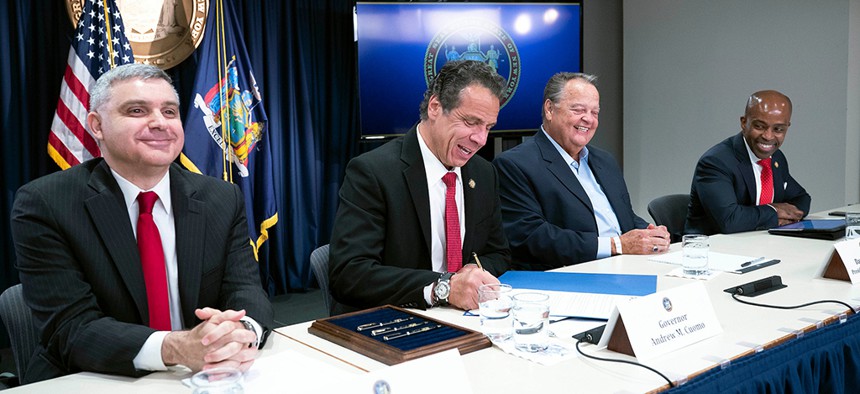New York State
Cuomo’s anti-Janus labor law may divide workers, critics contend
Governor Andrew Cuomo’s anti-Janus labor law may divide workers, critics contend.

Governor Andrew M. Cuomo signs an executive order to protect union members from harassment and intimidation. Mike Groll/Office of the Governor
Gov. Cuomo’s damage control in response to Janus vs. AFSCME began before the executive order he signed Wednesday that prevents state agencies from revealing employee contact information. In April, with the Supreme Court mulling the case, Cuomo signed a law aimed at helping unions recruit and retain members if the court ruled against organized labor, by allowing public sector unions to withhold full benefits of membership from non-members. However, the law is not universally accepted by unions and their allies as the best response to right-to-work laws.
On Wednesday, as was widely expected, the court’s conservative majority held that public employees cannot be forced to pay union dues. In New York, the state with the highest union-density of any state’s workforce, an 67 percent of the state’s union membership in the public sector, the change could significantly weaken unions.
In preparation for this moment, the New York state budget included an amendment to the Taylor Law, a statute originally passed in 1967 that redefined a union’s duty of fair representation. The new law clarifies the scope of the Taylor Law by reducing the number of services that New York’s public-sector unions must provide to workers who opt not to join the union. The unions, for example, will not have to provide certain union-specific benefits such as free legal representation, pension counseling or continuing education to non-members.
The scope of the law is limited, though. It importantly does not stop unions from representing non-members in collective bargaining. What it does do, say critics of this method of organizing, is undermine worker solidarity by pitting those who pay to support the union against those who do not. Chris Brooks, a union organizer and journalist for Labor Notes, argues that even though these measures secure membership and funding in the short-term, it is not the best response to decisions like Janus and right-to-work laws, which allow workers to opt out of paying union fees, in the long run.
“Unfortunately many unions have become very legalistic organizations that have focused a lot on providing services to members in negotiating contracts on their behalf, as opposed to organizations that bring members together around issues they care about and engaging in workplace fights. So my hope is that, more and more, unions recognize that they need to become more militant,” said Brooks.
Alan Klinger, a partner of Stroock & Stroock & Lavan who helped craft the Taylor Law amendment, said he agreed unions need to balance an affirmative message for non-members, but they also need to address a potential free-rider problem. If employees can get all the benefits of unions without paying dues to them, many may opt not to join the union. As union membership declines, this could lead to a death spiral in which the remaining members pay more and more as fewer people join, forcing the dues to go higher and higher and further decreasing membership.
“I see the validity that unions need to focus a need to have a positive message of what they can accomplish for workers. I think that should be the primary directive,” said Klinger. “I also think that there is a political, economic and sociological underpinning regarding the free rider syndrome that needs to be recognized.”
Klinger added that one of the benefits of New York organized labor is that labor and management work together when appropriate. “There are times when there's very hard bargaining across the table, but we're fortunate in New York that management believes in collective bargaining,” he said.
Both points of view agree that the task ahead for unions is to show workers the benefits of membership. The disagreement is over how to balance the individual incentives against mobilizing employees. This tension had been resolved by unions often operating as closed shops in which membership was mandatory. Now that is no longer an option in the public sector and the best course forward for labor isn’t yet clear.
Update: This article has been updated to include Gov. Cuomo's executive order on Wednesday.
Correction: This article originally misquoted Chris Brooks. He said "workplace fights," not "workplace sites."

NEXT STORY: The Long Island outlook

